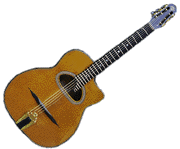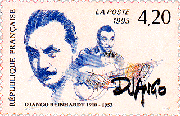
Background
information
the rest of the site
Get in touch
|
On the subject of wood
choices, here's a continuation of a conversation I had with Sam Powrie
from Australia on wood choices for Selmer-style guitars.
SP: Which Selmer guitars sound ‘best’ - I mean in terms of which wood do you feel is best suited for the basic design? PH: Boy, that's a tough question! The top wood, meaning usually the spruce, is at least 90% of it. In any kind of guitar. Can't emphasize that enough. As in any guitar, the body woods color the sound, but, as a number of luthiers have striven to prove (successfully, like Torres, with his paper guitar) you can make the body out of just about anything and get a good sound if the top is good. As you know, most Selmer bodies were made of a very thin laminate of Indian rosewood, usually with two other layers of mahogany or one each of mahogany and poplar in the center - just three plies. This was a deliberate plan of Mario Maccaferri's - to make the guitar very light and strong, to work with his internal resonator as the 'actual' body of the guitar. At that, with the resonator taken out or designed out, they still sound great. Ask Django Reinhardt. On Maccaferri's brief watch at Selmer, a few solid mahogany and maple guitars were made, but he prescribed plywood for all the production items. Tops on bodies of this ultra-thin ply sound great. In fact, from across a room, there's no way to tell the sound of one body wood from another, although the player often can. Most of the woods, be they laminated or solid, end up sounding enough alike that one is inevitably led to the conclusion that the top is what really counts the most. How the guitarist feels about the stringed thing in his own lap is quite another issue, one that deserves a bit of talk sometime. It's important to make that distinction. But then there is the issue of maple. Is it crisper and brighter? Maybe. I have a conflict: again, my primary belief is that the top makes for 90%+ of a guitar's sound, yet I find maple guitars (regardless of style of construction) tend to take several years to open up. The latest bloomers, by far. Maple starts out harsh and unhelpful, but ages nicely. This is, to me anyway, almost axiomatic about maple anywhere, though I certainly know exceptions to this. My Dupont MD20 is French maple; it rated "pretty OK" at first, and is devastating now, much more of a guitar than I deserve actually. Violinmakers love American maple, except it isn't as cooperative under the tool as European maple is. But the sound is completely there. In a way, it flies in the face of the notion that the top is so important, but I have to also say that any guitar should sound great the moment it is strung up - for it will only improve.. I can't explain this, but I do accept it. And to confound the issue even more, much of that isn't even playing so much as waiting. For example, in 1978, I designed the SCGC H model, and then in 1979 scrapped the molds and redesigned it, bird-dogging the construction of the first six. Of those, the least interesting (by far) was maple and Sitka - in 1979. Guess what? It's now the best. That said, two body woods that have struck me as really different are African mahogany and plain koa. They add a measure of warmth, perhaps a nuttiness of sound, that seems quite noticeable. It's impossible to get, though. Plain koa works every bit as well, and it's easy to get - everyone wants the flashy looking stuff, which, in my estimation, generally doesn't sound as good. They can have it. Martin proved this decades ago with their 18K and 28K series guitars, which had koa tops as well as sides and backs. The 18s were of plain koa, and the 28s had fancy, and the 18s generally always sounded way better. The only solid mahogany early (1932-33) Selmers I have seen were all of African mahogany (Khaya ivorensis), although François Charle asserts they were made from Cuban mahogany. I still hold that it was African, since that was much more in use globally and especially in Europe then. It's all anyone (including Martin, Harmony, Guild, Goya, Gibson, et al) used until the late 50’s. It's not a true mahogany, but it looks just like mahogany. Ribbony grain, and quite a bit harder. When the supplies ran thin in the late 50’s, Martin reserved African for necks, and switched to Honduras for bodies - a softer wood. Next stop: tops. I love Selmers with western red cedar tops. Hardly anyone beside a few new makes (including Favino) has had the guts to try them, but they sound wonderful. An intergrade wood, tonally, is Port Orford Cedar, which I know from experience is stunning. You cannot miss with spruce, however. It's the main wood, and for good reason. Repeat: The top produces most of a guitar's
sound and personality, no matter what the design. The body woods merely color
it.
Have a topic you think is worth some discussion here?
This page © 2002-2007 Paul Hostetter. All rights reserved. |

